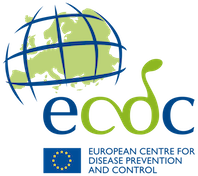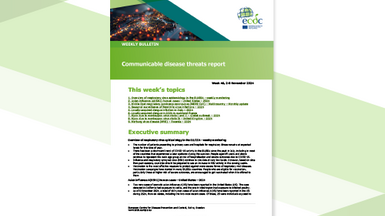Communicable disease threats report, 15-21 February 2015, week 8
The ECDC communicable disease threats report is a weekly bulletin intended for epidemiologists and health professionals in the area of communicable disease prevention and control. Summarising information gathered by ECDC through its epidemic intelligence activities regarding communicable disease threats of concern to the European Union, it also provides updates on the global situation and changes in the epidemiology of communicable diseases with potential to affect Europe, including diseases that are the focus of eradication efforts.
Executive Summary
This issue covers the period 15 to 21 February 2015 and includes updates on Ebola virus disease, seasonal Influenza, botulism in people who inject drugs, MERS-CoV
Ebola virus disease epidemic – West Africa
As of 15 February, WHO is reporting 23 253 cases of Ebola virus disease (EVD) related to the outbreak in West Africa, including 9 380 deaths. According to the weekly WHO, Ebola activity stabilised in West Africa last week with 128 newly confirmed Ebola cases reported in the three countries compared with 144 during the previous week. ECDC published a rapid risk assessment on 4 February 2015.
Seasonal influenza 2014-2015
In the past week, 15 countries reported stable and increasing influenza activity. The overall proportion of influenza positive samples and the total number of sentinel influenza virus detections decreased slightly which may be indicative of several countries having passed their peaks of influenza activity. ECDC monitors and reports on influenza activity in Europe on a weekly basis throughout the flu season.
Botulism in people who inject drugs - Norway and the UK
In the past week, two new cases of wound botulism have been reported in people who inject drugs in Oslo, Norway. Since December 2014, 25 cases of botulism have been reported in Norway (10) and Scotland (15) affecting people who inject drugs. Four additional cases are under investigation in Scotland. These cases raise the possibility that a batch of contaminated heroin is in circulation.
Middle East respiratory syndrome – coronavirus (MERS CoV)
Since the last update of 10 February 2015 and as of 19 February, Saudi Arabia has reported 35 additional cases of MERS-CoV. To date, all cases have either occurred in the Middle East, have direct links to a primary case infected in the Middle East, or have returned from this area. The source of the virus remains unknown, but the pattern of transmission and virological studies points towards dromedary camels in the Middle East being a reservoir from which humans sporadically become infected through zoonotic transmission.
Since April 2012 and as of 19 February 2015, 1 040 cases of MERS-CoV have been reported by local health authorities worldwide, including 414 deaths.
Download






